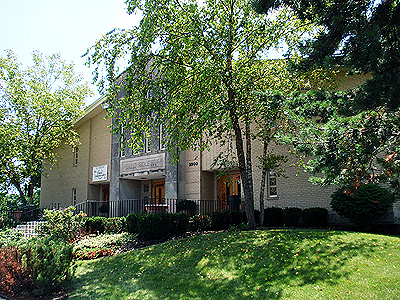Nestled within the verdant landscape of Rolling Meadows, Illinois, the address 3900 Owl Drive (formerly Meadow Drive) whispers tales of suburban evolution and the enduring human impulse to cultivate community. While seemingly a commonplace residential location, a closer examination reveals a fascinating tapestry woven from post-war expansion, architectural aspirations, and the subtle shifts in societal preferences that have shaped the region.
The narrative of 3900 Owl Drive begins not with bricks and mortar, but with a broader understanding of Rolling Meadows’ genesis. Post-World War II America experienced an unprecedented demographic shift toward suburban living. Veterans returning home, buoyed by the GI Bill and a burgeoning economy, sought affordable housing outside the crowded urban centers. This demographic surge fueled a construction boom, transforming vast tracts of farmland into meticulously planned residential communities, and Rolling Meadows epitomizes this era of profound transformation.
Rolling Meadows itself emerged as a meticulously planned community, a testament to the burgeoning field of urban planning that prioritized accessibility, green spaces, and a sense of communal identity. The very street names, evocative of nature, underscore this deliberate emphasis on a pastoral ideal. The renaming of Meadow Drive to Owl Drive may be considered a signifier of maturation, shedding a bucolic simplicity for the more subtle and mysterious qualities of nature.
The architectural style of the homes in the vicinity of 3900 Owl Drive often reflects the prevalent trends of the mid-20th century. Ranch-style houses, with their low-slung profiles and sprawling layouts, were particularly popular. Characterized by single-story construction, attached garages, and ample windows, these homes offered a practical and aesthetically pleasing solution for the burgeoning middle class. The floor plans often emphasized open-concept living spaces, a departure from the more compartmentalized layouts of earlier eras. Such designs fostered a sense of informality and encouraged family interaction. Imagine families gathering in these very spaces, shaping their lives, and weaving themselves into the fabric of the neighborhood.
Beyond the physical structure, the landscaping surrounding 3900 Owl Drive contributes significantly to the overall aesthetic and the sense of place. Manicured lawns, meticulously trimmed hedges, and carefully selected trees reflect a commitment to order and visual harmony. These meticulously curated landscapes served as an outward expression of the homeowner’s pride and contributed to the collective identity of the neighborhood. The interplay between the built environment and the natural world creates a uniquely suburban character. It is a character marked by the attempt to harmonize human habitation with the soothing balm of nature.
Delving deeper, the history of 3900 Owl Drive is intertwined with the social and cultural dynamics of Rolling Meadows. As the community matured, its residents established schools, churches, and community organizations. These institutions provided essential services and fostered a sense of belonging. Community events, such as parades, festivals, and neighborhood gatherings, further strengthened the social bonds that united the residents. The address becomes more than a location; it becomes a node in a network of human interaction and shared experiences.
Over the decades, the demographic profile of Rolling Meadows has evolved, reflecting broader societal shifts. While the community initially attracted predominantly young families, it has gradually become more diverse in terms of age, ethnicity, and socioeconomic background. This demographic evolution has brought new perspectives and enriched the cultural tapestry of the area. Consider the untold stories of the individuals who have resided at 3900 Owl Drive, each contributing their unique narrative to the larger story of Rolling Meadows.
The architectural landscape of the neighborhood surrounding 3900 Owl Drive has also undergone subtle transformations. While many of the original ranch-style homes remain, some have been renovated or expanded to accommodate changing family needs and preferences. Contemporary additions often blend seamlessly with the existing architecture, reflecting a commitment to preserving the character of the neighborhood while adapting to modern lifestyles. These alterations act as physical metaphors for the ongoing evolution of community values and shifting design sensibilities.
Looking ahead, the future of 3900 Owl Drive and the surrounding neighborhood is inextricably linked to the broader trends shaping Rolling Meadows. As the community continues to grow and evolve, it will face challenges related to infrastructure, housing affordability, and environmental sustainability. Addressing these challenges will require innovative solutions and a collaborative spirit among residents, policymakers, and community organizations. The story of a single address illuminates broader societal trajectories, demonstrating that local history is always relevant to the ongoing narrative of human experience.
In conclusion, the history of 3900 Owl Drive is a microcosm of the larger story of suburban development in post-war America. From its roots as a meticulously planned residential community to its ongoing evolution as a diverse and vibrant neighborhood, the address embodies the enduring human impulse to create a sense of place and build a thriving community. The subtle shift from Meadow Drive to Owl Drive signals a deeper understanding of nature and a maturation of place. Understanding this history offers a valuable perspective on the forces that have shaped the region and provides insights into the challenges and opportunities that lie ahead. So, when passing by 3900 Owl Drive, remember that beneath the surface lies a rich tapestry of stories waiting to be discovered, transforming an ordinary address into an extraordinary lens through which to view the evolution of a community.
